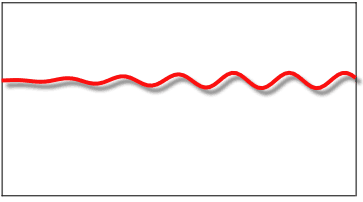Vibrato
What is it?
It's a wavering of pitch, brought about as follows...
- Play the note high up the neck
- Take the left-hand thumb off the back of the neck
- Keeping the finger-tip anchored on the string, wiggle the hand up and down the length of the neck a little
- This wiggling tightens and slackens the vibrating half of the string a tiny bit
- You'll find that when you're doing it properly, the wrist and the elbow go in opposite directions, so it's as if your arm is swivelling back and forth and there's a spot in your forearm that's staying still
- Don't go too fast - your guitar will sound like Edit Piaf!
What is it for?
It will add life to an otherwise plain note.
The ear is equipped to detect change - we are all aware, perhaps, of when the washing machine finishes. The ear starts to ignore constant noise and only perks up when there are changes - it's not suprising, because in primitive times a change of noise often heralded danger.
Vibrato creates the illusion of extra sustain because the constant change keeps the ear interested for longer.
How do I start practising it?
Vibrato is easiest up the neck - from frets 7 to 12.
The fingertip doesn't move on the string, but by moving the hand along the line of the neck, using the finger as a pivot, lateral forces are transmitted through the finger to the string that alter its tension enough to create vibrato.

A nice touch
For classy vibrato, start it just after the note sounds and build it up, like a flute player or singer does on a long note
"But I can't do it in lower positions"
Low down the neck, it's not possible to do vibrato effectively, because the two "halves" of the string are very different lengths and the short half resists, rather than helps, the finger change the tension of the long (sounding) half.
That's because the change in pitch is caused by changing the tension of the string (the vibrating length is fixed by the fret wire).
In the centre region of the string, it's easy to pull the string tighter, because the non-vibrating half helps you.
Down near the first first fret, as soon as you pull the string a little tighter, the non-vibrating part loses tension. As soon as you try to push the string towards the bridge to lower its tension, the tiny non-vibrating part is having none of it - it can't stretch by enough millimetres.
We can still do vibrato though...
- On a note low down the neck, wiggle the finger side to side (pull the string towards the higher string, and push towards the lower one)
- Don't overdo it (especially on steel strings)
- This type of vibrato raises the pitch both ways (you're stretching the string whether you push or pull), and so if done to excess, it creates the illusion the entire note is slightly sharp
A word of caution
If you're nervous and it's a hot day, watch out - the 4th string will require some intense "digging in" to make the vibrato sing, and if you're not careful, then the first note you attempt on the 3rd (monofilament) string will be greeted with a very slippery string. You might find your finger actually sliding and possibly missing the fret.
Download this teach-in
Download an e-book of all the teach-ins
Back to the FAQs contents